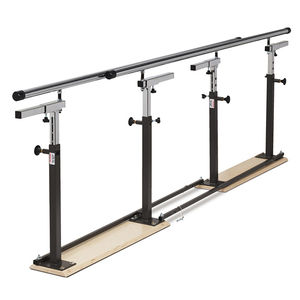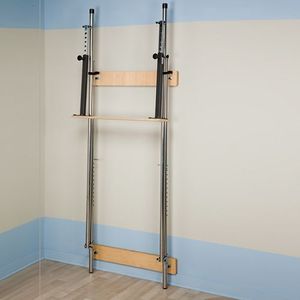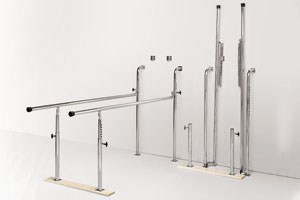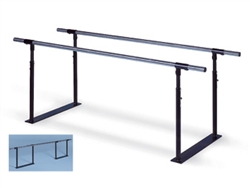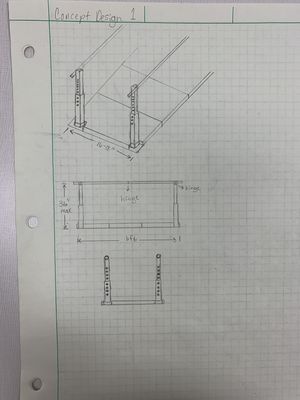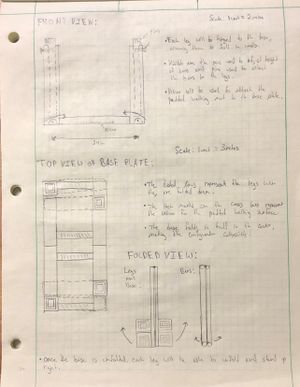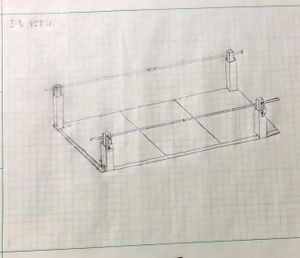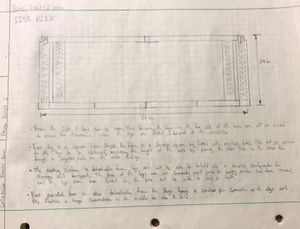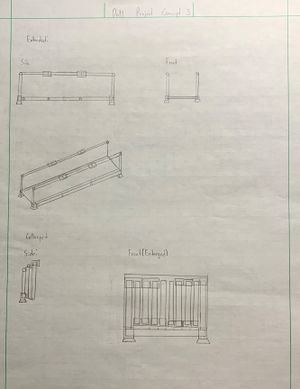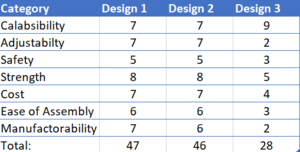Collapsible Parallel Bars
Abstract
Our parallel bars are for Aiden; He is one and has down syndrome. These bars will him develop the balance and strength needed to walk. The family wants them to be collapsible and transportable.
Team members
- Taylor McCarty, Weston Johnson, Eathan Allbert
Problem Statement/overview of the need
The project is a collapsible set of parallel bars that are able to be used both indoors and outdoors. What is unique about this project is that is for a one year old. These bars are needed for a kid that has down syndrome and needs help building his lower body strength to be able to walk. The bars need to be small enough for a one year old to use but be able to grow as he grows. The bars being able to collapse allow his family to take it to different locations so he has the ability to help himself stand no matter where he is.
Design Specifications
- Bars must be collapsible and usable inside and outside
- Bars must be able to fit into a PT Cruiser and Nissan Maxima
- Family wants the design to be six feet long
- Aiden is 31 inches tall, so we want the bars to have a minimum height of 24 inches.
- The bars must be able to grow with Aiden for a few years; therefore, were going for a maximum height of 36 inches.
Background research
1. What exists already, similar products
- What already exists is parallel bars that connect to walls and those can be really only been found in a physical therapists office. Regular parallel bars also exist but they take up a lot of room.
2. availability
- Parallel bars are available with the cheap ones being upwards of $600. The better more expensive ones are upwards of $10,000.
3. identify gaps in existing products or technology to be addressed
- The gaps in the technology are that there is only height or width adjustability, not both at the same time. Also the walkways are not collapsible which is what our project consists of.
Conceptual Design
Design Concept 1
This design utilizes adjustable vertical supports similar to fitness equipment like squat racks and flat benches. It also uses a folding mechanism similar to the legs on a folding table to aid in collapsibility. It also has a pad at the base to make the bars more kid friendly.
Pros 1. Collapsibility 2. Ease of assembly 3. adjustability 4. Simplicity
Cons 1. Hinges could be difficult to manufacture
Design Concept 2
- The parallel bars are removable from the legs and folds in half, they are attached to the legs by a pin connection.
- The legs are offset from one another and fold inwards on a hinge.
- Each leg is a square tube. Inside the tubes is a smaller square leg fitted with multiple holes. This allows for the legs to be extended, increasing the height of the bars by lining up the outer hole and one of the inner holes, pinning the outer tube to the inner tube.
- The legs are also connected to the bottom base plate, which folds in half.
- A detachable rubber mat will Velcro onto the base plate.
- Pros:
Compactible
Good range of height
User friendly
- Cons:
Assembling the hinges in a practical manner
Hinges and pins may cause pinching hazard
Design Concept 3
- The bars closest to the left are able to rotate inward as well as collapse the bars next to each other.
- There are inserts for the bars to snap into to keep in place.
- The floor is able to fold on itself.
- The vertical links are square shapes, and the horizontal bars are cylindrical.
- Mats are able to attach to the floor for softer walkway.
- The feet on the bottom allow for better traction on ground
- Pros:
Theoretically Stable
Versatile in many environments
Moved by Pressure alone
User Friendly
- Cons
Height is not adjustable
Complicated to make
Collars are a pinch hazard
Small pieces are a hazard
Evaluate concepts/select candidate
- We ranked each design based on seven categories out of 10, the first design won by a slim margin. Therefore, going into the conceptional design meeting, Design 1 is the lead candidate.
Detailed Design
This section will describe a detailed design process
Description of selected design
Detailed description of selected design
Analysis
Describe three types of analysis to be performed on the design
Compressive Forces on the Uprights
Total Weight
Bending Stress on the Bars
CAD Drawings
Insert drawings of all parts and the assembly
Bill of Materials
qty, item, description, source, part number, price
Assembly Instructions
Fabrication Process
Insert pictures of fabrication process
Testing and implementation
Describe testing, delivery, how used/received by the family
Photos of Completed design
Insert pictures of the final product
Instructions for safe use
Provide a clear summary of safe use for the family. Do not use the device unless supervised by an adult that has been fully understood the safe use of this product.

